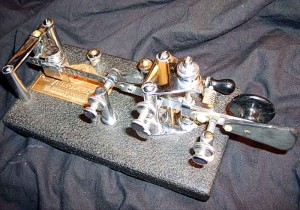`June 30, 2011 — I’m finally back to offer some views of my latest acquisitions … or did they acquire me? (Sometimes I can’t help but wonder if there isn’t a “Twilight Zone” episode buried somewhere here in my shack and amidst all my bugs, but I digress …).

1951 VIBROPLEX LIGHTNING BUG. A wonderfully well-kept key, complete with (slightly damaged) original case. The key bears what appears to be a Signal Corps stamp on the bottom, which corresponds to a Signal Corps Battalion that existed in the Korean War era. The “plain metal” screws (used to hold the circuit closer and other parts of the key together) appear to still carry evidence of receiving anti-fungal treatment, which was common for metal parts heading into tropical areas. I may be all wet on this, but the key definitely bears a military stamp on the bottom.

I’ve been shooting photos of keys this evening, and didn’t play with it yet on the air. It’s very, very nice. I’ll put it through its paces later.
One of the interesting things that I realized tonight was that Vibroplex apparently used the triangular paddles on its Champion, Zephyr and Lightning Bug keys for some years after it had shifted to the “new” rounded style used with the redesigned Original that debuted during World War II. I have Vibroplex Original keys dated 1945 and later, and they universally were equipped with the more stylized and rounded finger knob and thumb piece. The three keys that did not use a cast pivot frame or damper continued to use the older style knob and triangular paddle.

I don’t know what at what point the company started equipping all its bugs with the same knob and thumb piece; probably was a mix-and-match thing for a few years.
As I mentioned last night, the latch on the carrying case was locked, and the then-owner used a hacksaw to cut off the latch at the lock. I successfully picked the lock and unlocked it allowing me to remove the cut-off part of the latch. My plan is to gently pry off the latch part (the part that is on the lid), and I’m going to make a replacement latch arm that will extend into the lock mechanism and allow the latch to actually latch. Right now it flops open and doesn’t secure the key at all. A little time with some thin steel stock and a Dremel and I should have something done in short order.
I have a couple of other acquisitions that my wife will probably shoot me over; more about those in a later post.

KATSUMI KM-23 PADDLE. This key was one that arrived from eBay several months ago — kinda ugly but in mint condition (don’t know that “mint ugly condition” makes it worth more, lol!).
The KM-23 is a key that’s still in production. It isn’t quite as sexy as the Bencher BY-1, and it just looks like its built a little on the cheap side. I can tell you that if you spend a few moments setting the key up, it really is one of the smoothest keys you’ll operate.

I have the spacing on mine very close, and it has an excellent feel. I like the round look of the key (Bencher should follow suit). It has a nice brown, easy-to-care-for finish, and not a lot of chrome parts to fingerprint or clean. The key sells new from Morse Express for $99.95, which I consider to be a real bargain when you compare the cost of the inferior MFJ Bencher knock-offs. This key is the Chevy of iambic paddles …. not the sexiest key, but a dependable one that will get you where you’re going.

UNKNOWN HOMEBREW IAMBIC PADDLE. Another find on eBay, I bought it simply because I knew it was homebrewed and the worksmanship looked interesting. That it is!
One of the most interesting things about this key is that the key is magnetic — there are no springs. But there’s also no adjustment to the magnets on the return “attraction” of the magnets. Not that the lack of adjustment is a huge problem — it is not.
The key is very well laid-out — it appears to be expertly machined. The base appears to have been beadblasted or otherwise given some sort of surface treatment to give it a uniformly mottled finish. It’s an attractive way to finish brass, too. The base has this finish on top and bottom. The other parts are bright and polished.

As you can see in the photos, the contact adjustments were well-designed and are effective. This key is very much like the Brown Brothers BTL twin-lever paddle though the BTL used springs instead of magnets.
This homebrew’s key only failing (IMHO) is the fact that the paddle spacing is too far apart. I’m accustomed to using the Bencher BY-1 or similar iambic, and this key has a noticeably wider gap that makes using it awkward … at least for now. I’m sure after 30 minutes my mistakes and miskeyings would be at the “normal” level (which is too high to mention in a public forum).

The key’s base isn’t super heavy, but it doesn’t scoot around on the desk. There’s no identifiers on the key, but the workmanship is very professional. I wouldn’t be surprised to find that someone cranked out a couple hundred of these as an experiment.
Regarding the paddle spacing, the one thing I have not tried is to move the paddle to the inside of the lever (right now the paddle is on the outer side of each lever). I’ll have to keep my eye out for other similar keys; so far this one looks like one-of-a-kind.
-30-
